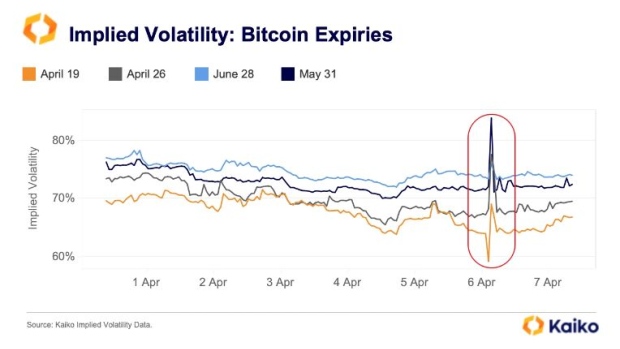Apr 12, 2024
Bitcoin’s Implied Volatility Rises as Nerves Fray Before Halving
, Bloomberg News

(Bloomberg) -- One of the options market’s closely watched indicators is starting to show that speculators are getting nervous ahead of a once-every-four-years Bitcoin code adjustment that has been bullish for the cryptocurrency in the past.
The implied volatility for Bitcoin options jumped last weekend, reversing a downward trend seen in the prior week, Kaiko Research said in a report. An increase generally means market participants are less confident about the direction of prices, said Adam McCarthy, a research analyst at Kaiko. When implied volatility rises, traders are usually willing to pay more to protect existing positions or to speculate on potential prices moves — up or down.
Bitcoin whipsawed investors on Friday, with the price swinging in a more than 8% range while global financial markets were roiled by a flare-up in geopolitical risks.
Implied volatility on contracts expiring in the next two weeks has increased the most, from 59% to 71% in the span of just 2 days, Kaiko said, suggesting that expectations for near-term volatility are rising.
“In this case it’s likely more bearish as traders are uncertain, but are willing to pay more for options to get protection against price swings,” McCarthy said. “They’re possibly paying high premiums to buy downward protection.”
After a mostly one-way surge in Bitcoin since the January approval of US exchange-traded funds to hold the cryptocurrency, the price has swung in a range in the past month. Traders are now focusing on what’s known as the halving, when the rewards in the form of additional tokens that so-called miners get for verifying transactions on the blockchain will be cut in half. The event is slated for around April 20.
“I think [the spike in Bitcoin expiries] is really related to people betting on the demand of Bitcoin on the day of the halving, where it will be even more expensive because the supply will be contracted,” said Bartosz Lipinski, founder and CEO of Cube Exchange. “It’s a very unique event in the Bitcoin history because you have two forces that effectively will be creating pressures on the price that’s already normally pretty inelastic.”
Previous halvings show short-term impact has been mixed, while the long-run has been bullish, another Kaiko report shows. In two out of the three previous halvings, prices surged one and three months afterward, the report explains. In all three halvings, prices surged nine and 12 months afterward.
However, Kaiko highlights that a sample size of three is not necessarily large enough to be conclusive, and researchers consider noted that other bullish events in the industry contributed to the gains.
©2024 Bloomberg L.P.





